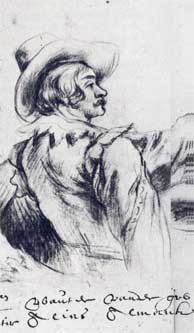Wouter Crabeth II
| Wouter Crabeth II | |
|---|---|

Wouter Crabeth, the Almanac
|
|
| Born | 1594 Gouda |
| Died | 18 June 1644 Gouda |
| Nationality | Dutch |
| Known for | painting |
| Patron(s) | Cornelis Ketel l’Ancien |
Wouter Pietersz. Crabeth II (1594 – c. 18 June 1644) was a Dutch Golden Age painter.
Wouter Crabeth was born in Gouda in 1594, the son of the writer and politician Pieter Woutersz. Crabeth. He was named after his grandfather Wouter Crabeth I, who was a celebrated master glassmaker. Crabeth took an apprenticeship under Cornelis Ketel, uncle of Cornelis Ketel le Jeune, who was well known. It is possible that he was also a student of Abraham Bloemaert in Utrecht.
In 1613, Crabeth made his Grand Tour. Such a tour, ending in Florence and Rome, was considered a necessary rite of passage for completing a Flemish artist's classical education, ever since Karel van Mander's Schilderboeck was published in 1604. He was in Paris in 1615 and in Aix-en-Provence the following year. Then he travelled to Italy, where he studied the local masterpieces and worked at the various painting schools and workshops. In 1619, while in Rome, he became a member of the Bentvueghels, with other painters such as Cornelius van Poelenburgh, Bartholomeus Breenbergh, Wybrand de Geest and Leonard Bramer. They gave him the nickname "De Almanack" (The Almanac). Crabeth is represented in an anonymous drawing (see sidebar in top-right) drawn in 1620 and saved in the Museum Boijmans Van Beuningen in Rotterdam. Crabeth was then known as Wouter van der Gou (i.e. Wouter of Gouda); he was often seen together with other members of the Bentvueghels.
In 1626, he returned to Gouda, as a schutter, (soldier). In 1628, he married the mayor's daughter, Adriana Gerritsdr Vroesen. The same year, at the time that his own father became mayor, he was named captain of the Schutterij, a function which he continued until his death in 1644. In this role, in 1629, he took part in the Siege of 's-Hertogenbosch.
...
Wikipedia
